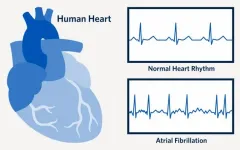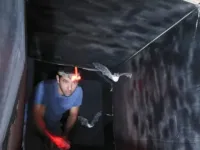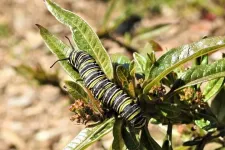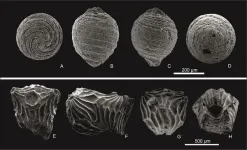(Press-News.org) When light hits certain molecules, it dislodges electrons that then move from one location to another, creating areas of positive and negative charge. This "charge transfer" is highly important in many areas of chemistry, in biological processes like photosynthesis and in technologies like semiconductor devices and solar cells.
Even though theories have been developed to explain and predict how charge transfer works, they have been validated only indirectly because of the difficulty of observing how a molecule's structure responds to charge movements with the required atomic resolution and on the required ultrafast time scales.
In a new study, a research team led by scientists from Brown University, the Department of Energy's SLAC National Accelerator Laboratory and the University of Edinburgh used SLAC's X-ray free-electron laser to make the first direct observations of molecular structures associated with charge transfer in gas molecules hit with light.
Molecules of this gas, called N,N?-dimethylpiperazine or DMP, are normally symmetric, with a nitrogen atom at each end. Light can knock an electron out of a nitrogen atom, leaving a positively charged ion known as a "charge center."
Intriguingly, this process is uneven; light absorption creates a charge center in just one of the two nitrogen atoms, and this charge imbalance deforms the molecule's atomic scaffolding, so atoms compensate by shifting position with respect to each other. But within three trillionths of a second, the charge redistributes itself between the two nitrogen atoms until it evens out and the molecules become symmetric again, the researchers report in a paper published in the Proceedings of the National Academy of Sciences today.
Their study is the first to directly observe how a molecule's structure changes as charge is redistributed, with some chemical bonds getting longer and some shorter, before finally relaxing back into its original state.
"We see the molecules breaking symmetry and reforming symmetry," said Peter Weber, a chemistry professor at Brown University whose research group started studying DMP almost a decade ago. He led the study with Adam Kirrander of the University of Edinburgh and SLAC senior staff scientist Michael Minitti.
A lopsided response
Scientists in Weber's group, including Xinxin Cheng - a PhD student who is now a SLAC associate staff scientist - discovered the molecule's lopsided response to light eight years ago. It turned out that the molecule's nitrogen atoms are just the right distance apart to make it an ideal model for studying charge transfer, a discovery that triggered a lot of discussion among theorists working to understand these processes as well as efforts to observe them in more detail.
In this latest study, Haiwang Yong, a PhD student in Weber's lab, worked with SLAC scientists to provide a much more direct observation of DMP's response to light. They hit DMP gas with pulses of light followed by extremely short, ultrabright X-ray laser pulses from the lab's Linac Coherent Light Source (LCLS). The LCLS X-rays scattered off the molecules in a way that revealed the positions of individual atoms, the lengths of the bonds between them and how they changed over just a few trillionths of a second.
"It is fascinating to see how the X-rays can resolve the changes in molecular structure that arise from charge transfer," Kirrander said.
Weber said the results demonstrate the value of the technique for extracting more detailed information than in previous experiments. The research team used that information to test theoretical models of how molecules respond, revealing flaws in the conventional approach known as density functional theory. Weber noted that the data seems to support detailed theoretical calculations of how these charge transfers take place by Hannes Jonsson of the University of Iceland, who was not involved in this study.
Minitti, who has been working on DMP with the Brown lab from the start and participated in this study, said it has been difficult to get a theoretical understanding of how these asymmetric systems work because the experimental data on them has been so sparse and indirect.
"This work is a significant step forward," he said, "giving us critical information about how the molecule responds during the charge transfer process. Research like this takes a village - we need experiments to inform the theory, and vice versa, to help us visualize this thing."
Going forward, a big increase in the pulse repetition rate of the LCLS X-ray source is underway, with a leap from 120 pulses per second to 1 million pulses per second. This will allow researchers to study much more complex systems, informing the development of new approaches to solar energy generation and energy storage technologies, among many other applications.
INFORMATION:
LCLS is a DOE Office of Science user facility, and the Office of Science funded this work.
Citation: Haiwang Yong et al., Proceedings of the National Academy of Sciences, 3 May 2021 (10.1073/pnas.2021714118)
SLAC is a vibrant multiprogram laboratory that explores how the universe works at the biggest, smallest and fastest scales and invents powerful tools used by scientists around the globe. With research spanning particle physics, astrophysics and cosmology, materials, chemistry, bio- and energy sciences and scientific computing, we help solve real-world problems and advance the interests of the nation.
SLAC is operated by Stanford University for the U.S. Department of Energy's Office of Science. The Office of Science is the single largest supporter of basic research in the physical sciences in the United States and is working to address some of the most pressing challenges of our time.
Researchers from the UCLA School of Dentistry have discovered a key molecule that allows cancer stem cells to bypass the body's natural immune defenses, spurring the growth and spread of head and neck squamous cell cancers. Their study, conducted in mice, also demonstrates that inhibiting this molecule derails cancer progression and helps eliminate these stem cells.
Published in the journal Cell Stem Cell, the findings could help pave the way for more effective targeted treatments for this highly invasive type of cancer, which is characterized by frequent resistance to therapies, rapid metastasis and a ...
A hot topic symposia session during thePediatric Academic Societies (PAS) 2021 Virtual Meeting will provide a forum for policy and physician experts to predict major child health legislative and policy changes which will occur over the next four years.
The outcome of the presidential election has significant impact on the child health policy agenda. The goal of the session is to prepare academic pediatricians so they can be ideally positioned to promote or impede specific policies which are not evidenced-based to improve child health.
"The subject matter ...
The emergence and spread of new forms of resistance remains a concern that urgently demand new antibiotics. Transcription is a vital process in bacterial cell, where genetic information in DNA is transcribed to RNA for the translation of proteins that perform cellular function. Hence, transcription serves as a promising target to develop new antibiotics because inhibition the transcription process should effectively kill the bacteria. Bacterial RNA Polymerase, the core enzyme for transcription, must load the DNA and separate the double-stranded DNA to single stranded DNA to read the genetic information to initiate transcription. This process is also called DNA melting and is facilitated ...
ORLANDO, May 5, 2021 - New research indicates that the legendary Sargasso Sea, which includes part of the Bermuda Triangle and has long featured in fiction as a place where ships go derelict, may actually be an important nursery habitat for young sea turtles.
In a study led by a University of Central Florida researcher and published today in the journal Proceedings of the Royal Society B, researchers presented evidence of baby green sea turtles arriving at the Sargasso Sea after entering the ocean off the east coast of Florida.
The study was the first time that green sea turtles have been tracked during their early "lost years," which is defined ...
A UBC Okanagan researcher is urging people to learn and then heed the symptoms of Atrial Fibrillation (AF). Especially women.
Dr. Ryan Wilson, a post-doctoral fellow in the School of Nursing, says AF is the most commonly diagnosed arrhythmia (irregular heartbeat) in the world. Despite that, he says many people do not understand the pre-diagnosis symptoms and tend to ignore them. In fact, 77 per cent of the women in his most recent study had experienced symptoms for more than a year before receiving a diagnosis.
While working in a hospital emergency department (ED), Dr. Wilson noted that many patients came in with AF symptoms that included, but were not limited to, shortness of breath, feeling of butterflies (fluttering) in the chest, dizziness or general fatigue. Many women ...
Seeing through smog and fog. Mapping out a person's blood vessels while monitoring heart rate at the same time--without touching the person's skin. Seeing through silicon wafers to inspect the quality and composition of electronic boards. These are just some of the capabilities of a new infrared imager developed by a team of researchers led by electrical engineers at the University of California San Diego.
The imager detects a part of the infrared spectrum called shortwave infrared light (wavelengths from 1000 to 1400 nanometers), which is right outside of the visible spectrum (400 to 700 nanometers). Shortwave infrared imaging is not to be confused with thermal imaging, which detects much longer infrared wavelengths ...
A new Tel Aviv University study has revealed, for the first time, that bats know the speed of sound from birth. In order to prove this, the researchers raised bats from the time of their birth in a helium-enriched environment in which the speed of sound is higher than normal. They found that unlike humans, who map the world in units of distance, bats map the world in units of time. What this means is that the bat perceives an insect as being at a distance of nine milliseconds, and not one and a half meters, as was thought until now.
The Study was published in PNAS.
In order to determine ...
PULLMAN, Wash. -- A count of the Western Monarch butterfly population last winter saw a staggering drop in numbers, but there are hopeful signs the beautiful pollinators are adapting to a changing climate and ecology.
The population, counted by citizen scientists at Monarch overwintering locations in southern California, dropped from around 300,000 three years ago to just 1,914 in 2020, leading to an increasing fear of extinction. However, last winter large populations of monarchs were found breeding in the San Francisco and Los Angeles areas. Prior to last winter, it was unusual to find winter breeding by monarchs ...
The idea of deriving health benefits from live microorganisms is well known, but some non-living microorganisms, too, can have beneficial health effects. Yet even with an increasing number of scientific papers published on non-viable microbes for health, the category is not well defined and different terms are used in different contexts.
Now, a group of international experts has clarified this concept in a recently END ...
A study published in Cretaceous Research expands the paleontological richness of continental fossils of the Lower Cretaceous with the discovery of a new water plant (charophytes), the species Mesochara dobrogeica. The study also identifies a new variety of carophytes from the Clavator genus (in particular, Clavator ampullaceus var. latibracteatus) and reveals a set of paleobiographical data from the Cretaceous much richer than other continental records such as dinosaurs'.
Among the authors of the study are Josep Sanjuan, Alba Vicente, Jordi Pérez-Cano and Carles Martín-Closas, members of the Faculty of Earth Sciences and the Biodiversity Research Institute (IRBio) of the University of Barcelona, in collaboration with the expert Marius Stoica, ...







